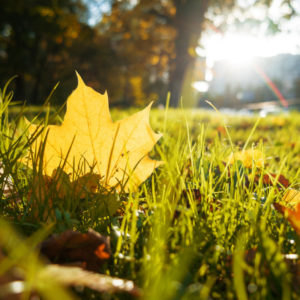
As fall approaches, it is not the time to neglect your lawn maintenance. The months of September, October, and November are when you need to put the most focus on your lawn. Instead, homeowners need to use this time to start preparing your lawn for winter. However, knowing how to protect your lawn in the winter is crucial. That is why we are sharing a few tips and tricks that you can use to help prepare your lawn for the fall and winter.
The Importance of a Healthy Lawn
Fall is the time when grass prepares to go dormant. That is why lawn care in the fall can make it or break it for a healthy lawn during the springtime. Lawn care in the fall has the highest return for long-term, year-round lawn health. Lower light, cool fall temperatures, and higher rainfall are nature’s signals for lawn grass to begin a final growth period before winter.
A healthy lawn doesn’t happen on its own. Luscious lawns come from attention all year long, which means nurturing, feeding, and protecting grass from disease, insects, drought, and damage from all types of threats. Healthy lawns add significant value to your property. Nothing makes a better overall curb appeal statement than a well-cared-for manicured lawn. Plus, a healthy lawn is excellent for the environment!
Healthy lawn areas significantly contribute to sound reduction, where noise pollution is a big issue in urban areas. Lawns are a primary defense against soil erosion. Lawns provide security by creating distinct open zones where high-visibility deters unwelcome intruders. Healthy lawns even provide safety by creating firebreaks. In city sites, lawns do a great job of mitigating heat.
What Happens to Your Lawn in the Winter?
Have you always thought that your lawn dies in the winter then grows back in the spring? Well, that’s not the case. Your entire lawn remains alive, but the grass plants do freeze in the winter. The grass blades above ground die off in the winter, but just below the ground, your lawn’s roots are very much alive. This is how your lawn can survive harsh winter conditions and can come back to life in the spring.
The Process of Protecting Your Lawn for Winter
The process of preparing your lawn for winter is pretty straightforward. It’s a matter of understanding what natural response your lawn has and why it acts the way it does. However, getting your lawn ready to survive the winter can be time-consuming. Grass plants naturally respond to temperature and daylight. Therefore, it is important to work within your lawn’s critical time window. In most places, crucial timing is over a few weeks. If you have a large lawn area, you may want to consider contracting a lawn maintenance company to prepare your lawn for winter properly. Experienced lawn professionals have the knowledge, skills, materials, and equipment to make your lawn’s winter treatment easier and save you valuable time.
Check out our tips for protecting your lawn for the fall and winter below:
CLEAN UP DEBRIS
Large items like branches, logs, leaves, lawn furniture, and kid’s toys left on the grass over winter have a devastating effect on grass health. Surface coverage blocks top-side air and creates large dead spots come the spring. These are unnecessary and easily preventable.
MOW GRASS THE RIGHT HEIGHT
You need to leave different species of grass at different heights before winter. There’s a standard one-third rule where you should never cut grass more than one-third of its standing height. That means grass that’s 3 inches tall should only have one inch removed, leaving the blade two inches tall.
AERATE YOUR LAWN
Aeration is one of the best possible things you can do to care for your lawn and prepare it for winter. Aeration involves boring holes into the soil and removing small plugs left to dry and decompose on the lawn surface. These portals to grass’ roots let water, air, and fertilizer freely drain down to where they’re needed.
Pre-winter conditioning is all about root building for lawns. You should do the aeration late in the fall just before your final cuts. This lets the roots, rhizomes, and blades recover from aeration trauma and set themselves up for dormancy.
Proper aeration takes knowledge and skill. It needs a precise, uniform pattern as over-aeration can severely hurt your grass. There are manual aerators available, but they’re not practical for large areas. Power aerators that professional lawn maintenance companies own are the best way to go.
FERTILIZE YOUR LAWN BEFORE WINTER
Once you’ve cleaned your lawn of debris, cut, and aerated it, it’s necessary to fertilize it before winter arrives. When choosing the right type of fertilization, you should understand fertilization ratings. These ratings are N for nitrogen, P for phosphorus and K for potassium. High nitrogen fertilizers are great for the spring because they promote leafy vegetation growth. However, for the fall, you will want to select a fertilizer with a high P-rating. Also, note that some fertilizers are water-soluble, and others are slow-release granular types. We recommend granular fertilizer high in phosphorus for winter preparation.
SEED, RAKE, AND WATER
We recommend that you seed your lawn before winter. Blend cold season seed to germinate in cool soil and get a foothold before the entire lawn goes dormant. You can spread the seed by hand or with a spreader. It is essential to make sure to give your new seeded lawn to sprout before winter sets in. Two weeks before freezing is usually enough to let them root and start a short blade. All that’s required is just a little raking to spread everything and a minimal amount of water to make sure your lawn is ready for winter.
We hope that these steps help you get your lawn prepared for the fall and winter this year. If you need any landscaping assistance, contact us to learn how we can help!


Recent Comments